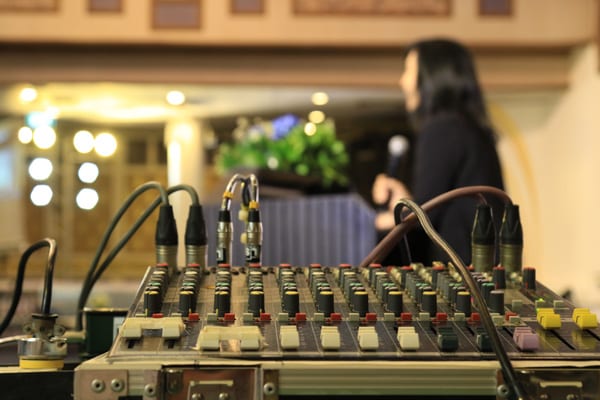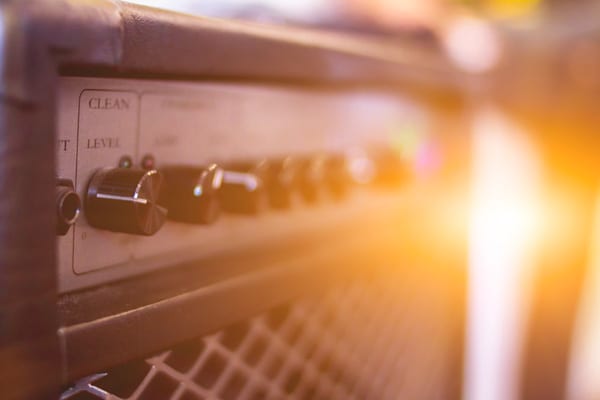Basic Audio Visual
Planners and attendees are not audio visual technology experts
Built-in speakers will suffice when the A/V presentation is made to a small group of people. However, for a larger audience that is seated in a comparatively big conference room, it is necessary to use amplifiers. Then again, you may encounter a situation where you need to make your audio track more flexible. Sometimes during an A/V session, different sound sources need to be combined with the video source. Since a variety of audio sources are involved in this process, using mixers is the best way to combine the audio and video seamlessly.
Mixers and Amplifiers
An amplifier, or amp, is a device that modulates the amplitude of a sound signal. Generally, the signal is a current or voltage. The electronic amplifiers that are available in the market today are effective in increasing the sound signal, so that the audio can reach the far corners of a large room, which most small speakers cannot do.
There are two important components of an amplifier, and they are the transfer function and the gain of the amplifier. The transfer function determines the relationship of the input to the output of the amplifier, and the magnitude of the transfer function is called the gain.
A mixer is an electronic device which is often used for changing the quality and the levels of audio signals. It is also known as a mixing console, an audio mixer, or a soundboard. Using a mixer is the most convenient way to route or combine various audio signals and even change the timbre and dynamics of the sound. The high-end mixers that are available today can effortlessly mix analog and digital signals, making your audio integrate with the video to give a perfectly consistent and coherent A/V experience.
Understanding Audio Visual Cabling
It is vital when preparing an important business conference that all the equipment is properly set up. Cabling ensures the proper function of equipment and careful placement of cables ensures the safety of meeting attendees.
- Test all equipmentbefore the meeting.
- Soundis the most crucial part of the meeting.
- Make sure there are enough electrical outlets.
- Consider how many pieces of electronic equipmentwill be used.
- Arrange the sound systemin an unobtrusive manner and make sure the volume is set in advance.
- Check all visual diagramsto make sure cable and plugs are placed properly.
- Double checkthe inputs on each piece of sound equipment
Most audio visual equipment comes with specific instructions and diagrams. Reference the instructions for all equipment that will be used at the meeting. It is very helpful to sketch the room layouts and configure placement of all audiovisual items and cabling. Measure the actual room to determine space between placement of laptops, audio recorders, or TVs. Factor in the measurement of cords and connecting cables. Eyeballing the space can be helpful at first, but make sure to double check the actual size of the room. This especially helps to make sure you have enough slack to safely cover and conceal the cabling.
Avoiding Audio Feedback
One of the most effective ways to avoid audio feedback is by simply switching off the microphone before you turn on your audio system. Furthermore, you should make sure that the microphone input volume is turned down to its lowest level. After the system is turned on, you can gradually raise the microphone volume.
Ring Out the Microphone
Audio feedback can also be reduced by “ringing out” the microphone. It is a process where professional sound engineers turn down the band equalizer’s frequency. This prevents audio feedback at a particular pitch, and at the same time, it allows the maximum possible volume to be played
Use an Anti-Feedback Device
Yet another method of avoiding audio feedback is by purchasing automatic anti-feedback devices. These devices are known in the market as feedback destroyers or feedback eliminators. They can reduce the high-pitched squealing noise significantly by up-shifting the frequency of the feedback
Wireless Microphone
Wireless microphones use a battery to transmit the radio waves across the frequency to the receiver. This means that a strong battery should be used at all times. When the battery begins to lose steam, the microphone may sound scratchy or distorted, especially during the recording process. Experts recommend replacing the battery after several uses and before problems arise.
To install the wireless microphone, users should turn off the transmitter but turn on the receiver. Most wireless microphones now come with an automatic setting that scans the area and selects the right frequency for use with the system. Once the frequency is found, the user can adjust the volume of the receiver to the appropriate level for the situation and turn on the transmitter. They can then sync the transmitter and receiver and make any adjustments they think is necessary.
Make Your Presentation Heard
First, you need to determine how many people and what the size of the room you’ll be giving the presentation in. If you’re giving a presentation in a small conference room, you may be able to utilize the internal speakers in your laptop. This would be effective for a small group of up to 10 people, seated in close proximity to the laptop.
If the room is slightly larger, and you will have a few dozen people watching and listening to your presentation, then pa system rental should work well with the computer rental.
If the presentation is in a large room, like a hotel ballroom or large conference room, you will need special stereo speakers in order to be heard by several hundred people. However, a laptop with a sound card should be able to handle the task.
For a large conference room, or ballroom, you should find out if the hotel or conference center has an existing sound system. If they do, inquire to see if you need anything in addition to an audio cord to interface with the sound system.
Interactive Whiteboards
An interactive whiteboard is an effective tool for communicating information to any group. This twenty first century technology can be of assistance to a teacher who is delivering an exciting lesson to a classroom of children. Also, just as easily, an interactive whiteboard can be used to explain data and statistics at a business meeting. An interactive whiteboard serves its purpose of displaying all sorts of information in an interesting format.
One of the benefits of using an interactive whiteboard is the ability to manipulate the information that is being shown. First, The Use of an Interactive Whiteboard requires that it is connected to a computer turning it into a, “..live computer desktop..” The image and information on the computer are then displayed on the interactive whiteboard. A significant feature of the interactive whiteboard is that it allows its user to apply markings to the text, drawing, chart, or other piece of information that is being projected. For example, a teacher explaining a population chart with the assistance of an interactive whiteboard has the use of bright colors, easy-to-spot graphics, and distinct images at his or her fingertips.
We’d love To Meet You In Person Or Via The Web!
Main Office: Suite M-01, 512, 3rd Street, Abu Dhabi, UAE
Phone: + 971 2 6767019
WhatsApp: + 971 55 3979668
Email: web@OfficePlusUAE.com







